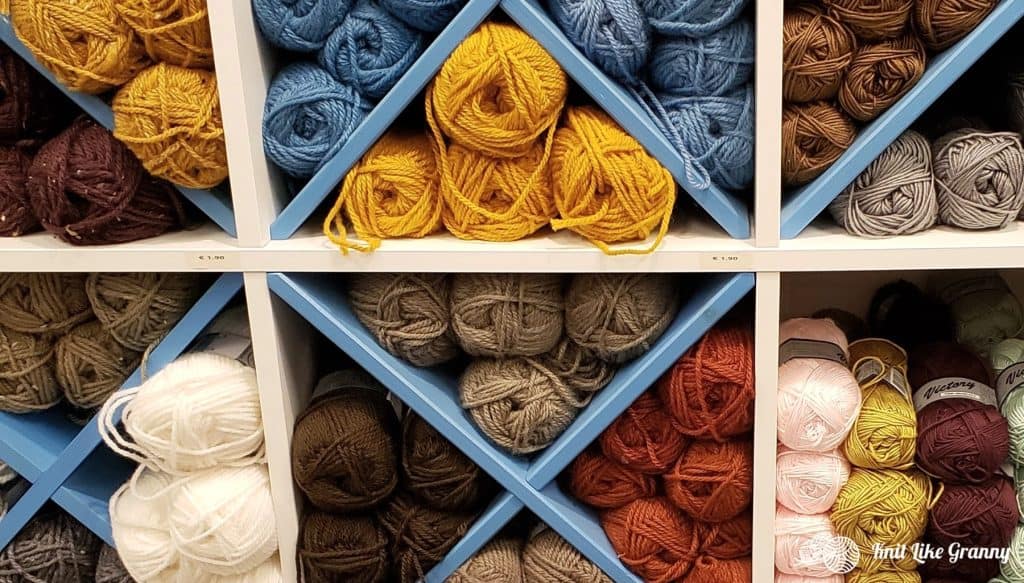Mastering color changes is crucial in knitting, particularly for stripes and intricate designs. Here, I’ll cover some simple techniques to help you change colors.

Table of Contents
Preparing
First and foremost, it’s important to choose the right yarn and needles for your project. Make sure you have enough of each color, and keep in mind the main color and contrasting colors for your desired pattern. When preparing to change colors, it is helpful to have a new ball of yarn ready to go.
Spit Splice Join
One of my favorite techniques is the spit splice join, an efficient method for joining new colors in both knitting in the round and regular knitting. Follow these steps for a seamless join:
- Split the tail of the old yarn and the new yarn in half.
- Moisten the ends of both half-split tails.
- Overlap the moistened ends and press them together.
- Roll the overlapped ends between your palms to create a splice.
- Continue knitting with the joined yarn, making sure to maintain your stitch pattern.
Tips & Tricks
When changing colors in knitting, it’s important to consider a few key points to ensure a seamless and professional-looking result.
Firstly, when working with yarn ends, I suggest weaving them in as you work rather than waiting until the end of your project. This will save you time and give your finished product a cleaner appearance.
To do this, simply weave the yarn ends through the stitches as you knit, catching the contrasting color with your working yarn.
It’s also important to choose the best type of knot for your project. Personally, I recommend using a “magic knot” to join the new color, as it is secure and less noticeable.
To make a magic knot, place the two yarn ends together and tie a simple knot, then tighten it by pulling the ends. Double-check that your knot is secure before continuing to knit.
Regarding fabric choice, cotton is an excellent option for colorwork projects as it provides a smooth finish and crisp stitch definition. Keep in mind, though, that cotton fibers can be less forgiving when it comes to hiding any knots or mistakes. On the other hand, natural fibers like wool have more elasticity and can “hide” flaws better due to their inherent fuzziness.
Heat is another factor to consider when changing colors, especially if you plan on felting your project. Felting involves using heat and agitation to shrink and bind fibers together, making them appear more solid and less like individual stitches. If your project calls for felting, make sure to choose wool yarns that can withstand the process.
Lastly, don’t be afraid to experiment with different techniques and color palettes. With practice and these tips and tricks in mind, you’ll be well on your way to creating beautiful, multi-colored knitting projects that you’ll be proud to show off!
Finishing
After completing your knitting stripes, Fair Isle, or other colorwork projects, you might find yourself with numerous yarn tails. Weaving in these tails is an important step to create a polished finish. Here’s my go-to method:
- Use a tapestry needle to thread each yarn tail.
- Weave the tail through the back of neighboring stitches, following the path of the existing stitches.
- Switch directions and continue weaving for another 1-2 inches to secure the tail.
- Trim any excess yarn close to the work.
Remember, practice makes perfect! With more experience, you’ll develop the confidence to tackle different colorwork techniques, and soon be able to create complex patterns in hats, sweaters, blankets, and more. Don’t forget that there are various tutorials, videos, and step-by-step instructions available to help you along the way. Happy knitting!
Frequently Asked Questions
How do I switch colors while knitting in the round?
When knitting in the round, it’s essential to have a smooth color change to maintain a neat appearance in your work. To switch colors while knitting in the round, follow these steps:
- Begin by knitting the last stitch of the old color with both the old and new color yarns held together. This helps to anchor the new color and prevent gaps in your work.
- Drop the old color yarn, but don’t cut it just yet. Instead, let it hang at the back of your work until you need it again, or if it’s no longer needed, weave in the ends later.
- Continue knitting with the new color yarn, making sure to maintain proper tension and avoid pulling too tight.
- When you come back to the join on the next round, knit the first stitch with both colors again to maintain a smooth transition. After that, continue knitting with the new color as usual.
Experiment and practice to find the method that works best for you and creates the neatest appearance in your project.
What is the best method to carry yarn when changing colors?
Carrying yarn when changing colors can be a bit tricky, but there are several techniques that can help you achieve a clean and even look in your knitting:
- Twist and weave method: This technique, introduced by Jane Crowfoot, involves twisting the two colors of yarn together and weaving the carried yarn into the work. It provides a crisp, even look in color changes and works well for both knitting and purling.
- Stranding or Fair Isle knitting: In this technique, the unused yarn is carried across the back of the work, creating small horizontal “strands” or “floats.” It works well when working with multiple colors and patterns.
- Intarsia: Intarsia involves using separate balls or bobbins of yarn for each color section, which eliminates the need to carry the yarn across the work. It’s ideal for knitting large, solid color patterns or when several colors are used in a row.
Choose the method that best suits your project’s needs and your personal knitting style.
Can garter stitch have an invisible color change?
Achieving an invisible color change in garter stitch might be a bit more challenging than in other stitch patterns, but it’s not impossible. Here are some tips to help you get a clean and nearly invisible color change in garter stitch:
- On the last row with the old color, knit until you’re two stitches away from the end of the row.
- Slip the last two stitches with the old color yarn.
- Pick up the new color yarn and knit the first stitch of the next row, leaving a tail to weave in later.
- Lift the slipped stitches over the first stitch knitted with the new color, mimicking the garter stitch pattern.
This method helps create a cleaner transition between colors and maintains the garter stitch’s characteristic texture. It might take some practice, but with patience, you’ll find it becomes easier.

Thank you very much. I was finding it difficulty to fibnd to find a detailed description. I will let my blinnd friends about you.
Thank you.